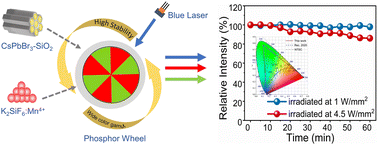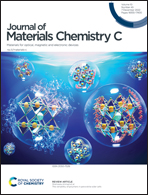A highly stable CsPbBr3–SiO2 glass ceramic film sintered on a sapphire plate for laser-driven projection displays†
Abstract
Laser-driven projection technology urgently requires green emitters with a narrow bandwidth, high quantum efficiency, and long-term stability to compensate for the “green gap”. Herein, a highly stable CsPbBr3–SiO2 glass ceramic film was synthesized by co-sintering high-photostability CsPbBr3–SiO2 powder and low-melting glass frit on sapphire, where the high thermal conductivity of sapphire and the SiO2 barriers could help maintain the stability of CsPbBr3 nanocrystals (NCs), endowing the well-known CsPbBr3 material with the possibility of application in the field of laser-driven projection displays. Furthermore, a “fluorescence wheel” was fabricated by pasting the CsPbBr3–SiO2 glass ceramic film on a micro motor, which could effectively alleviate the thermal quenching and increase the laser saturation threshold. Benefiting from its elaborate design, the operating temperature of the glass ceramic film was reduced from 351 °C to 75 °C and its luminescence intensity was maintained at 86% of its initial brightness at the laser power density of 4.5 W mm−2 for 60 min. As a proof-of-concept experiment, an all-inorganic multi-color fluorescent plate with red and green light emissions was obtained by combining the K2SiF6:Mn4+ phosphor and CsPbBr3–SiO2 powder in a patterned manner on sapphire, which provides an idea for the application of CsPbBr3 NCs and K2SiF6:Mn4+ phosphor in laser projection systems.



 Please wait while we load your content...
Please wait while we load your content...